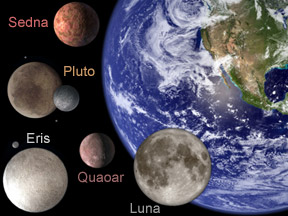Earth is much bigger than Pluto. It is also much bigger than Eris, another dwarf planet. Even Earth's moon, Luna, is bigger than the dwarf planets. This picture shows some other objects, Sedna and Quaoar. Do you think they are planets?
Click on image for full size
Original artwork by Windows to the Universe staff (Randy Russell) using images courtesy of NASA/JPL-Caltech/R. Hurt and NASA, ESA, and A. Feild (STScI).
What is a planet?
Do you know what a planet is? Guess what... astronomers are not quite sure what a planet is!
Mercury, Venus, Earth, and Mars are the planets closest to the Sun. They are definitely all planets. They are a lot like each other. They are called "rocky planets" or "terrestrial planets".
Jupiter, Saturn, Uranus, and Neptune are farther from the Sun. They are all planets, too. They are much bigger than the rocky planets. Jupiter and Saturn are called gas giant planets. Some people call Uranus and Neptune gas giants, too. Other people call them ice giants, because they are so cold.
Then there's Pluto. It is way out on the edge of our Solar System. It is much smaller than Mercury, the smallest rocky planet. Is Pluto a planet? Some people say yes. Other people say no.
There are many other large ice worlds in our Solar System. They are called Kuiper Belt Objects (KBOs). The KBOs are a lot like Pluto. Some people say Pluto is just another KBO. They say that KBOs are too small to be planets.
Some people say Pluto is a planet. Some of them say other KBOs are planets, too. Some people say that any KBO that is as big as Pluto or bigger is a planet. We may have 20 or more planets in our Solar System some day. Astronomers are finding new KBOs all the time.
A group called the International Astronomical Union is trying to make up a good definition for "planet". Until they decide, different people will call different objects planets. What do you think the definition of "planet" should be?
You might also be interested in:

Pluto is a frigid ball of ice and rock that orbits far from the Sun on the frozen fringes of our Solar System. Considered a planet, though a rather odd one, from its discovery in 1930 until 2006, it was
...more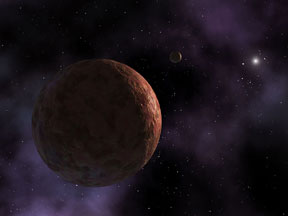
Astronomers have found a new object in our Solar System. The new object is named Sedna. Astronomers are calling Sedna a "planetoid". A planetoid is smaller than a planet but bigger than asteroids or comets.
...more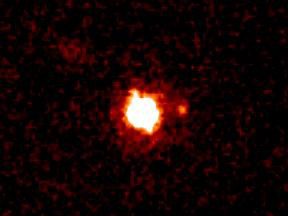
Eris is a dwarf planet in our Solar System. Eris is a lot like Pluto, which is also a dwarf planet. Eris and Pluto are both very far from the Sun. They are both very, very cold. Eris was discovered in
...more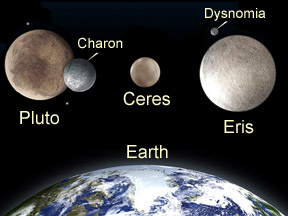
In 2006 the International Astronomical Union (IAU) approved a new classification scheme for planets and smaller objects in our Solar System. Their scheme includes three classes of objects: "small solar
...more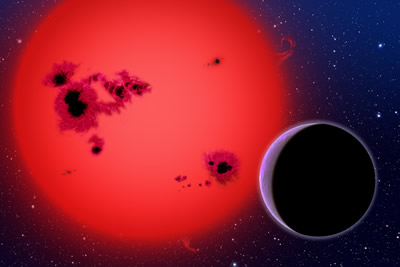
Astronomers have discovered a planet about 40 light-years from Earth that contains water. The planet, called GJ1214b, is a super-Earth, which means it is close to the size of Earth. It is too hot to contain
...more
There are lots of small worlds at the edge of our Solar System. They are made of ice and rock. They are further away from the Sun than most planets. They are further away than the 8th planet, Neptune.
...more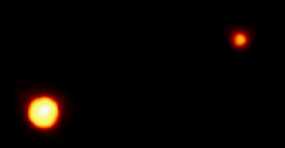
Pluto has been officially demoted from its status as a planet. The International Astronomical Union (IAU), at a meeting in August 2006, voted on their first "official" definition of a planet.
...more


